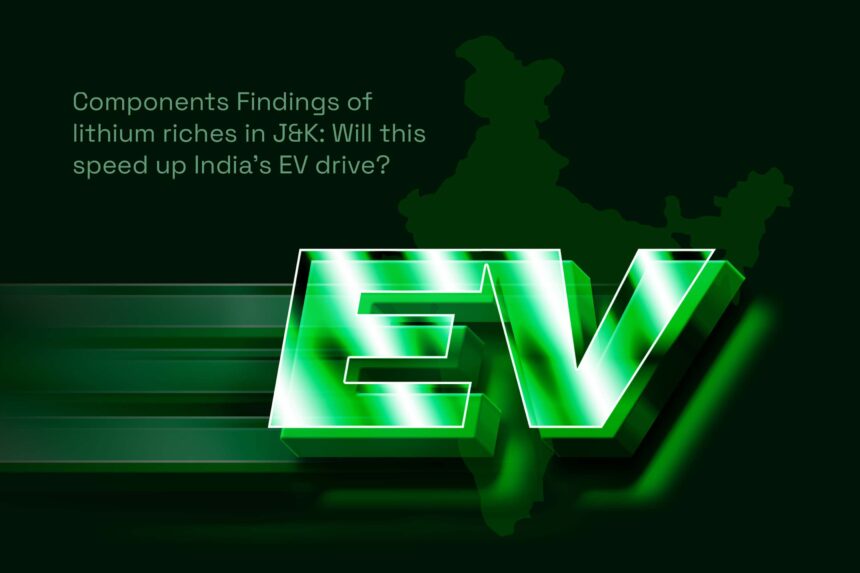In Jammu and Kashmir, 5.9 million tonnes of lithium reserves have been discovered for the first time in India, according to the Mines Ministry’s announcement on Thursday.
The Salal-Haimana area of the Reasi district of Jammu and Kashmir has 5.9 million tonnes of lithium inferred resources (G3), according to an announcement made by the Ministry of Mines on Thursday.
It also mentioned that 51 mineral parcels, including gold and lithium, were given to state governments. One of the most important components of EV batteries is lithium, a nonferrous metal.
In 11 states, including Jammu and Kashmir (UT), Andhra Pradesh, Chhattisgarh, Gujarat, Jharkhand, Karnataka, Madhya Pradesh, Odisha, Rajasthan, Tamil Nadu, and Telangana, there are 51 mineral blocks, according to the government. Five of these 51 mineral blocks are associated with gold, and the remaining blocks are associated with products like potash, molybdenum, base metals, etc.
The blocks were created using the work completed by GSI over the 2018–19 field seasons up to this point.
The EV boom’s catalyst: lithium?
The cost of lithium-ion batteries rose last year for the first time in the EV era, according to Bloomberg NEF. Elon Musk bemoaned the “insane” rise in lithium prices and asserted that one of Tesla Inc.’s biggest problems was the high cost of raw materials.
The central government has promised incentives worth at least $3.4 billion to speed up its sluggish EV adoption as Prime Minister Narendra Modi promises to attain net zero by 2070. According to the notion, making batteries locally will reduce the ultimate cost for the mass market and establish the country as a viable exporter, allowing it to capitalise on the increasing global demand.
Billionaires are interested in the initiatives, including Mukesh Ambani, whose Reliance Industries Ltd. is constructing an EV battery complex as part of a bigger $76 billion push into sustainable energy. Ambani’s is one of three companies—along with bullion refiner Rajesh Exports Ltd. and scooter producer Ola Electric Mobility Pvt.—that will receive incentives as part of a $2.3 billion programme to support the development of novel battery cells.
The world’s most populous country lacks a large fraction of the raw materials needed to meet domestic demand for lithium-ion batteries, which Crisil forecasts will multiply 100-fold by 2030, let alone produce them on a global scale.
The need for the metals used in lithium-ion batteries, such as lithium, nickel, cobalt, and others, is rising as society moves away from gasoline-powered internal combustion engines.
According to Manikaran Power Ltd. director Jasmeet Singh Kalsi, “the entry barriers are pretty substantial.” The company is constructing the first lithium refinery in India and searching abroad for nickel, cobalt, and copper assets. “Most of it has been seized by China.”
India still has a long way to go before catching up, and it also has to contend with rival nations like the US, which is pushing to increase local battery production in an effort to weaken China’s market dominance.
Why is lithium so popular?
Countries are phasing out cars that run on fossil fuels in favour of electric cars. The EU will mandate zero-emission standards for all new cars and vans starting in 2035, while the US plans to phase out all heavy-duty vehicles powered by fossil fuels by 2040.
Suppliers need a lot of rare earth metals to make the batteries for electric cars. Although graphite and cobalt are also used, lithium is the most popular.
According to Chris Berry, a lithium industry expert, the metal is preferred because it “holds a charge” and has a “30-year track record of use across a range of various applications,” in addition to being incredibly lightweight.
Approximately 317,517 metric tonnes of lithium were consumed globally in 2020, but according to industry predictions, that number might increase to six times as much by 2030. The EU will need 18 times more lithium than it does now by 2030 and nearly 60 times more by 2050 in order to reach its aim of being climate neutral by the middle of the century. According to Berry, the demand for lithium is increasing at a rate of roughly 20% annually on a global scale.
Where are all the mines for lithium?
There are several lithium reserves located all over the world. Lithium mines, however, are not. In both the United States and Europe, there is only one lithium mine in operation. Despite having roughly 4% of the world’s confirmed reserves, the US produces less than 2% of the world’s lithium. China dominates the global supply chain for lithium-ion batteries, with South America and Australia providing the majority of the world’s lithium. Berry asserts that “the Chinese definitely own 60 to 70% of the supply chain, in particular for lithium.”
Several potential new mine sites are being investigated by US developers. Lithium Americas has one project in mind for Thacker Pass in northern Nevada. Millions of tonnes of lithium would be made available if this mine were to be approved.
Ioneer, an Australian firm, also plans to establish a sizable lithium mine in Nevada. According to the company, this mine will have the capacity to produce 20,000 tonnes of lithium a year, which is enough to power hundreds of thousands of electric vehicles.
Therefore, even Nevada might join the race for lithium.
Conclusion
In the global situation of all countries trying to acquire lithium for their EV boom, the findings of lithium reserves in J&K might be a big boost for India’s race for lithium.







